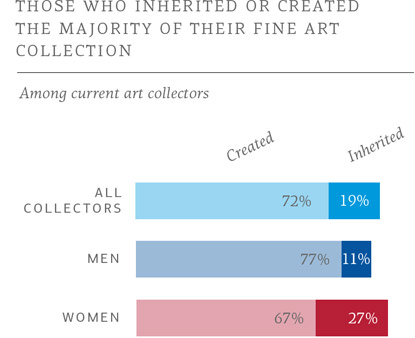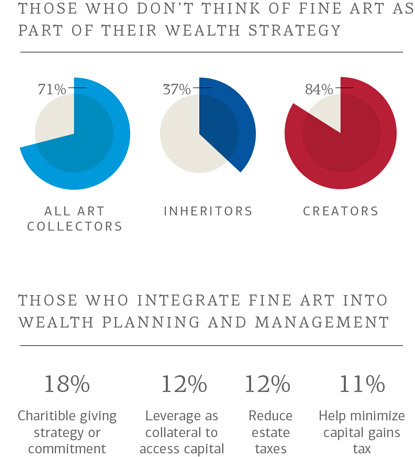Cindy Charleston Rosenberg, ISA CAPP sent me a recent US Trust report on collecting art. One of the more interesting points in the article as Cindy pointed out to is that according to the report "Seventy-one percent of high-net-worth collectors are not integrating art into their broader wealth strategy. This is in line with the fact that 69% note their primary interest for collecting art is for its aesthetic value."
With that leaves a lot of opportunities and challenges for the personal property profession in general and specifically for individual appraisers. This means there is a lot of untapped potential high net worth clients with legitimate needs for appraisals and art advisory.
The report looks at new generation of art collectors, inheriting art collections, building wealth through art collections and using art collections as collateral.
US Trust reports in its Insights on Wealth and Worth
Source: US TrustThe 2017 U.S. Trust Insights on Wealth and Worth® survey asked high-net- worth individuals about building a collection, inheriting art, and integrating art into a wealth strategy. The study reveals missed opportunities to realize the full value of an art collection.
The Newest Generation of Art Collectors
Art holds a place of great value among many high-net-worth families, and is likely to play a key role in intergenerational wealth transfer over the coming decades as Baby Boomers pass on approximately $30 trillion in assets to their heirs. This looming “great wealth transfer” can play a part in inspiring family conversations about passing down and receiving art as an inheritance.
Click on Image to Enlarge
Art is appreciated across the spectrum of high-net-worth individuals; almost one in five overall is a collector and another 16% are interested in collecting. Yet there are notable demographic distinctions. Women, Millennials, and Gen X-ers are all more likely to currently be collectors than men and older generations. Millennials show the greatest interest in becoming collectors, at 43% compared to 26% for Gen X.
Wealthy Millennials have a variety of reasons for collecting art, but they are the most likely to say that they enjoy being a part of the art world and artist community (38%, as compared to 28% of Gen X and 7% of Boomers). Thirty percent of Millennials also believe that art can be a safe haven amid volatile markets—this compares to just 17% of Gen X individuals and 7% of Boomers.
Passing Down an Art Collection to Heirs
Many high-net-worth individuals plan to pass down their art to heirs, but there is a marked generational disparity among those who are expecting to inherit art.
Click on Image to Enlarge
Millennials are most likely to have inherited their art (32%) and to expect to receive art as an inheritance (23%). This compares to just 8% of Gen X and 2% of Boomers who expect to receive art as an inheritance. Overall, only 19% of high-net-worth collectors inherited their art. Women are also twice as likely as men to be inheritors of art (27% compared to 11%).
Eight in 10 collectors plan to pass down their art to family, and two-thirds of them have had conversations on the responsibilities of caring for art. However, only 40% of inheritors or those who expect to inherit have discussed their lack of interest in art with family members. This may point to a need for more detailed discussions on art inheritance, allowing families to ensure their heirs are both willing and prepared to manage a family collection. If not, alternative legacy plans may be crafted.
Building Wealth Through Art
Seventy-one percent of high-net-worth collectors are not integrating art into their broader wealth strategy. This is in line with the fact that 69% note their primary interest for collecting art is for its aesthetic value.
Click on Image to Enlarge
That said, those who inherited rather than created their collections are much more likely to consider art as part of their wealth strategy (63%, compared to 16%). Millennials are also the most likely of any generation to consider art an asset that can be leveraged to build wealth (25%, compared to 22% for Gen X and just 6% of Boomers).
Collectors are considering art as part of their wealth planning by factoring it into charitable giving (18%), accessing capital by borrowing against their art (12%), and using art to minimize estate taxes (12%) or capital gains taxes (11%).
Critical family discussions on the tax implications of inheriting or passing on art are often not happening: just 27% of art collectors have held these discussions. Inheritors, or those who plan to inherit, have had these conversations in larger numbers (55%), but only 24% of those who plan to pass down art have had these talks.
Opportunity to Borrow Against Art
High-net-worth collectors often may not realize that they can leverage their art as a wealth-strategy tool—including accessing liquidity for more art purchases or other opportunities.
Click on Image to Enlarge
The art-lending market stands at $15 billion to $19 billion (value of average of loans outstanding).2 More men than women (8% to 1%) plan to borrow against their collection in the near term (within the next two years).
While individuals often may not realize they can leverage their art, the incidence of using art as collateral is increasing: in 2016, 7% of collectors said they owned art in order to leverage the assets as collateral. In 2017, 12% of collectors say they borrow against their art.
A larger percentage of men than women (41% to 17%) also anticipate purchasing one or more art pieces over the next two years.
Notably, collectors who have a professional advisor are more likely than those without an advisor to finance art with a bank-structured loan, and to strategically leverage, lend, or gift their art.





No comments:
Post a Comment